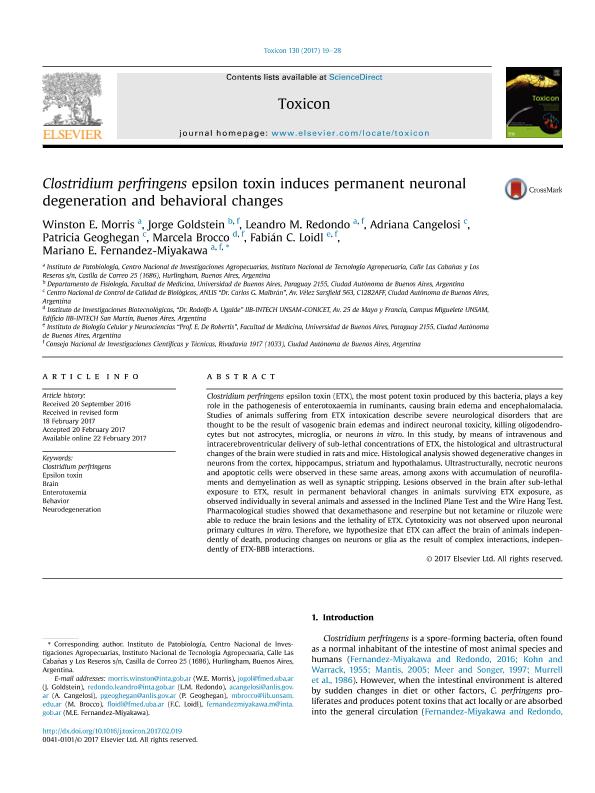Artículo
Clostridium perfringens epsilon toxin induces permanent neuronal degeneration and behavioral changes
Morris, Winston E.; Goldstein Raij, Jorge ; Redondo, Leandro Martin
; Redondo, Leandro Martin ; Cangelosi, Adriana; Geoghegan, Patricia; Brocco, Marcela Adriana
; Cangelosi, Adriana; Geoghegan, Patricia; Brocco, Marcela Adriana ; Loidl, Cesar Fabian
; Loidl, Cesar Fabian ; Fernandez Miyakawa, Mariano Enrique
; Fernandez Miyakawa, Mariano Enrique
 ; Redondo, Leandro Martin
; Redondo, Leandro Martin ; Cangelosi, Adriana; Geoghegan, Patricia; Brocco, Marcela Adriana
; Cangelosi, Adriana; Geoghegan, Patricia; Brocco, Marcela Adriana ; Loidl, Cesar Fabian
; Loidl, Cesar Fabian ; Fernandez Miyakawa, Mariano Enrique
; Fernandez Miyakawa, Mariano Enrique
Fecha de publicación:
05/2017
Editorial:
Pergamon-Elsevier Science Ltd
Revista:
Toxicon
ISSN:
0041-0101
Idioma:
Inglés
Tipo de recurso:
Artículo publicado
Clasificación temática:
Resumen
Clostridium perfringens epsilon toxin (ETX), the most potent toxin produced by this bacteria, plays a key role in the pathogenesis of enterotoxaemia in ruminants, causing brain edema and encephalomalacia. Studies of animals suffering from ETX intoxication describe severe neurological disorders that are thought to be the result of vasogenic brain edemas and indirect neuronal toxicity, killing oligodendrocytes but not astrocytes, microglia, or neurons in vitro. In this study, by means of intravenous and intracerebroventricular delivery of sub-lethal concentrations of ETX, the histological and ultrastructural changes of the brain were studied in rats and mice. Histological analysis showed degenerative changes in neurons from the cortex, hippocampus, striatum and hypothalamus. Ultrastructurally, necrotic neurons and apoptotic cells were observed in these same areas, among axons with accumulation of neurofilaments and demyelination as well as synaptic stripping. Lesions observed in the brain after sub-lethal exposure to ETX, result in permanent behavioral changes in animals surviving ETX exposure, as observed individually in several animals and assessed in the Inclined Plane Test and the Wire Hang Test. Pharmacological studies showed that dexamethasone and reserpine but not ketamine or riluzole were able to reduce the brain lesions and the lethality of ETX. Cytotoxicity was not observed upon neuronal primary cultures in vitro. Therefore, we hypothesize that ETX can affect the brain of animals independently of death, producing changes on neurons or glia as the result of complex interactions, independently of ETX-BBB interactions.
Archivos asociados
Licencia
Identificadores
Colecciones
Articulos(IFIBIO HOUSSAY)
Articulos de INSTITUTO DE FISIOLOGIA Y BIOFISICA BERNARDO HOUSSAY
Articulos de INSTITUTO DE FISIOLOGIA Y BIOFISICA BERNARDO HOUSSAY
Articulos(SEDE CENTRAL)
Articulos de SEDE CENTRAL
Articulos de SEDE CENTRAL
Citación
Morris, Winston E.; Goldstein Raij, Jorge; Redondo, Leandro Martin; Cangelosi, Adriana; Geoghegan, Patricia; et al.; Clostridium perfringens epsilon toxin induces permanent neuronal degeneration and behavioral changes; Pergamon-Elsevier Science Ltd; Toxicon; 130; 5-2017; 19-28
Compartir
Altmétricas



